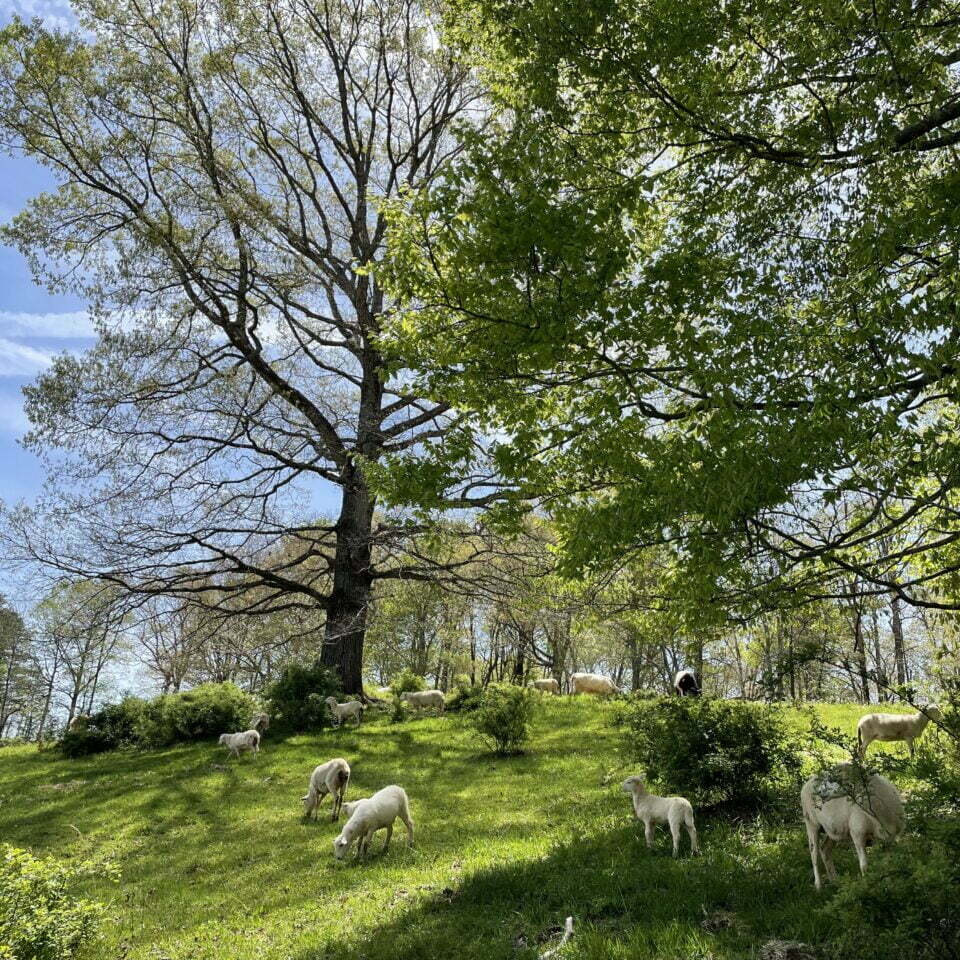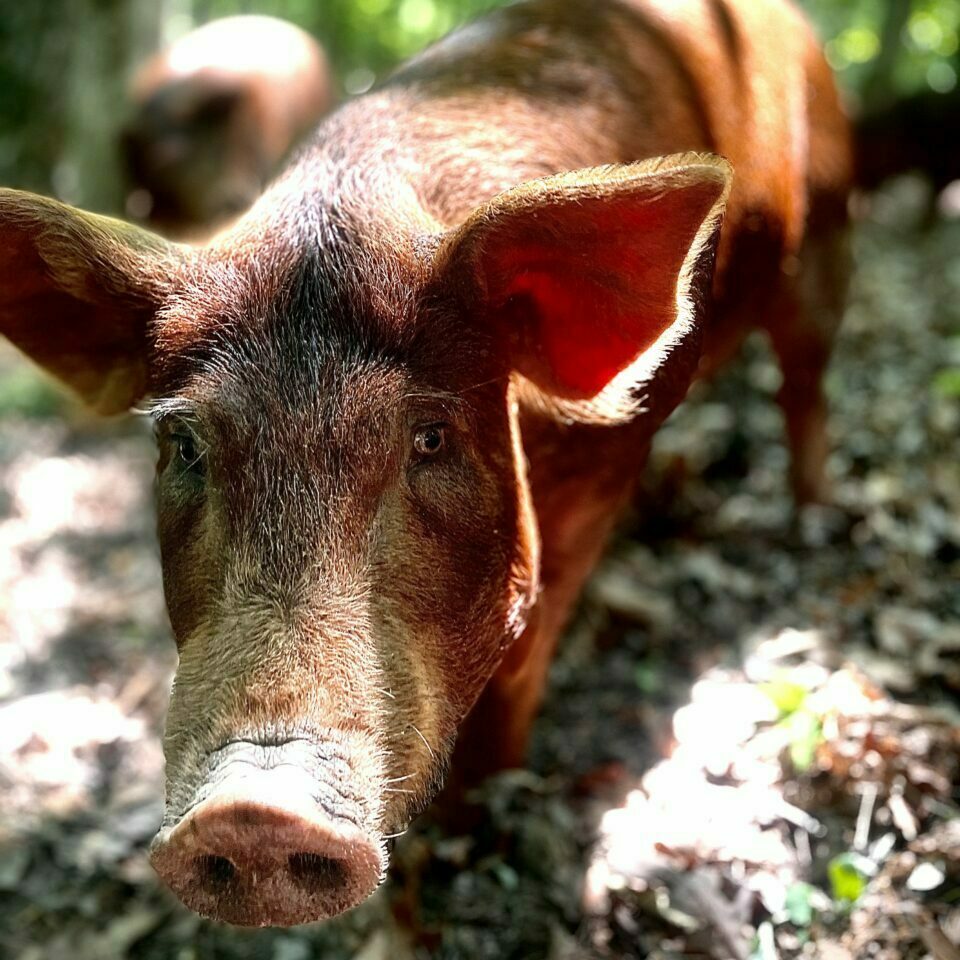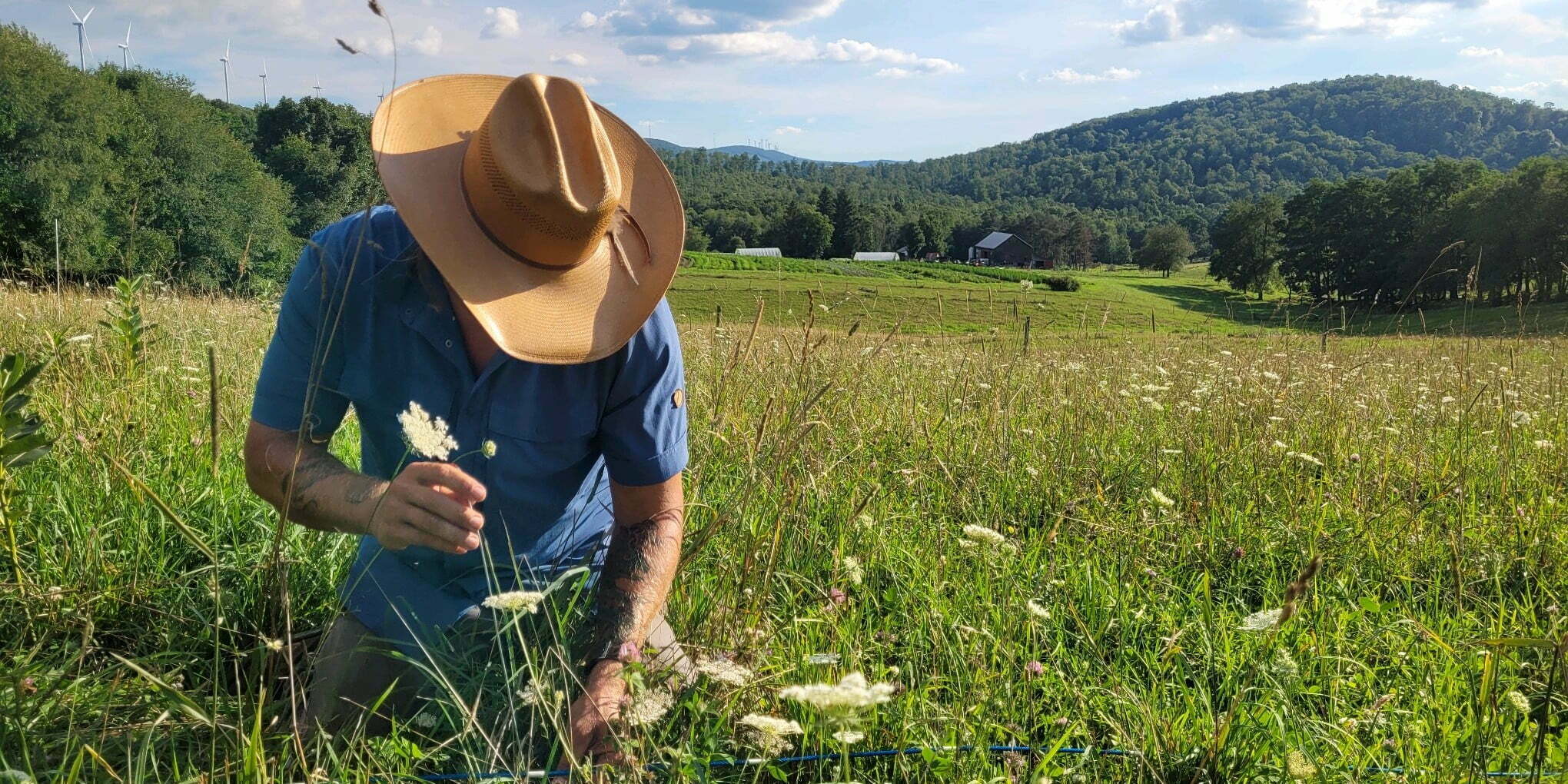Farmer Jake Puckett and his wife, Luna, spent last Christmas up all night caring for a sick calf inside their house. Meanwhile, the temperature plunged, waterlines went down, the tractor broke, and a new batch of ewes all started lambing at once. “There’s a commitment, physically and emotionally, to farming like this,” says Jake. “Death is an unfortunate reality when running a farm. It’s not the most beautiful side of farming, but it’s real.”
Deep care and transparency are part of what sets Crow Fly Farms apart. But foremost is the way the land is managed. Cows, sheep, and pigs graze and forage happily through both pasture and forest, along a foothills ridgeline in Marion, NC. The animals are living in a way that mimics natural systems—and at the same time, they are restoring the land’s ecological health. The goal is to transition the property, which Jake and Luna purchased in February 2021, to an entirely silvopasture system.

“On the most basic level, silvopasture is the integration of animals into a mixed forest grassland,” says Jake. “It’s a savannah-like system, bringing animals out of traditional pasture into areas of more diversity and complexity.” Through rotational grazing and other holistic measures the land will actually benefit from the animal impact. The animals will live their best lives and produce delicious, nutrient-dense meat.
From start to finish, Jake estimates that process will take three-and-a-half to four years. The first phase has been to run the hogs through the forested areas to clear out the understory. The hogs mulch and compost the leaf litter and provide manure to fertilize the soil as they are rotated through the forest. The next step, where they are now, is working with a logger to open up the tree canopy. Using a selective harvest, they’ll let in just enough light to get native warm-season grasses, forbs, wildflowers, and legumes established.
“We’re trying to leave as many trees as possible, but open up the canopy enough to get forage growing on the forest floor,” says Jake. “We won’t graze it in the first year so that the roots can develop and grow deep. The following year we’ll be able to bring in our cattle and sheep.”
They’re also working from the opposite direction, planting fast-growing trees and shrubs in the existing pasture to provide shade, weather protection, and food for the animals. Slower-growing trees, including fruit and nut varieties, are being planted as well to meet a long-term vision. Crow Fly Farms was one of four farms selected for the first phase of Carbon Harvest, a regional carbon offsets platform funding agroforestry projects.
“The animals struggled in hotter months on the portions of the property without trees,” says Jake. Hauling shade structures isn’t practical and can result in over-impacted areas around the structures. Trees provide natural shade as well as fodder through a process known as chop and drop. “Basically, we cut down portions of the trees, feed it to the animals, and it will regrow.” That gives them an organic feed supplement the farm can produce on its own, rather than purchase, and adds another layer of diversity. “Those deep-rooted trees will pull minerals up to the surface that grass is not able to, and both the animals and the grass will reap the benefits.”
Connecting with Customers

To ensure that no part of the animal would be wasted, Crow Fly began with a whole animal sales model, with minimums of a half hog, whole lamb, or quarter beef. Jake pitched his specialty, high-end product to Asheville restaurants and developed strong relationships with Chestnut and Blackbird. Animal shares were a way to connect with neighbors. But after about a year they realized they wanted a more accessible product. “We pigeonholed ourselves a little,” admits Jake. This winter, Jake and Luna started selling smaller meat boxes at farmers markets in Asheville. They worked with their processor to create custom bundles that make use of every cut. “We still know the whole animal is being used, but it’s an approachable amount of meat for someone to purchase.” Bundles vary from two to four pounds of meat to larger sampler sizes.
Farmers markets are also an important place to tell their story. “The best way to sell our product is to talk to literally one person at a time,” says Jake. “We’re educating consumers about the way we manage our farm, why it’s important, and why it’s different than what you would typically see. This is a more labor intensive and expensive way to raise animals, but people are buying into what we’re doing and they believe in us.”
After a calf is born, it will be three years before it’s processed. In that time, Jake will have moved it around the property five hundred or more times. He will have physically set up paddocks for each of those moves and hauled water to the animals around a thousand times. “So much care and work goes into raising animals in this system,” he says.
Farm tours are another way to show that effort. “ASAP’s Farm Tour [in September 2022] was amazing for us and introduced lots of new customers,” says Jake—though he admits it strained his voice. “I spend most of my days not speaking because I’m around animals,” he laughs. The farm began offering tours by appointment this year, giving people an up-close look at the animals and a chance to hear Jake’s passionate explanation of his farm practices. “Some farms don’t want customers to see behind the scenes, but this is something we want to show off.”
Embarking on a Dream

All of this is a pretty recent career shift. Jake grew up outside of Charlotte, but had been in Denver, Colorado, for 10 years, where he met Luna. Jake worked as a blacksmith and a sculptural stone carver, Luna was a yoga instructor, and together they operated a sourdough bread bakery on the side. Both were feeling unfulfilled and were looking for a change. With the onset of COVID, those conversations escalated.
“We are both very environmentally minded and started becoming more conscious of where our food came from,” says Jake. “Then we learned about regenerative farming practices and began to understand how much the food we eat can impact the environment. Meat production in particular gets a bad rap. We came to realize that through regenerative systems, meat production could be a means of healing the environment rather than degrading it.”
Though Jake had no farming experience, his father is a veterinarian and Jake spent much of his youth around animals on farms. He wanted to learn what it would take to raise them with the best life possible and produce high-quality food—while also positively impacting the environment. That research led him to the Savory Institute, a global network promoting large-scale regeneration of grasslands through holistic animal and land management. With a move back to North Carolina planned, he connected with the closest Savory Hub, the Robinia Institute in Virginia, and took a holistic management course. “That gave us the confidence and knowledge to proceed with this—I guess—dream,” he says.
Finding land was a challenge. Most of what was in their price range was unusable due to topography. Getting enough acreage to raise 100-percent grassfed animals meant going up against developers making cash offers. The land they eventually purchased had no infrastructure. They were already raising a few animals on Jake’s father’s property. In what felt like excruciatingly slow motion, Jake started to put his holistic management vision into place—and recorded the results. “A lot of what I’m doing is by obsessive observation,” he says. “I learn by looking at what’s going on out there.” He began to see improvement in the soil.
Jake is now an Accredited Professional with the Savory Institute and the lead Ecological Outcome Verification (EOV) monitor for the Robinia Institute. In addition to using the protocols for his own land, this past summer Jake traveled to about 30 other farms throughout the Southeast and Mid-Atlantic to conduct ecological monitoring.
“It’s an amazing protocol, because you’re putting hard numbers behind the term ‘regenerative,’ which is kind of a new buzzword,” Jake says. “It provides a feedback loop where you can see how your management is impacting the land by evaluating data. It includes soil sampling, water infiltration tests, species identification, forage estimates, the establishment of photographic plots, and a host of other metrics.”
In addition to EOV monitoring, Crow Fly Farms offers consulting and hosts trainings in holistic management. Both are ways to bring in additional income—but also build a community of farmers.
“I want there to be a network in place, a support system,” says Jake. “As a farmer it can sometimes feel like you are on an island. I want to be able to learn from each other and lean on each other. It’s an educational opportunity, but also just if you’re having a bad day being able to call another farmer and know you’re not the only person going through it. Building a community of like-minded farmers would be beneficial for all of us.”

